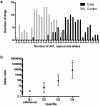Genome-wide association analysis in dogs implicates 99 loci as risk variants for anterior cruciate ligament rupture
- PMID: 28379989
- PMCID: PMC5381864
- DOI: 10.1371/journal.pone.0173810
Genome-wide association analysis in dogs implicates 99 loci as risk variants for anterior cruciate ligament rupture
Abstract
Anterior cruciate ligament (ACL) rupture is a common condition that can be devastating and life changing, particularly in young adults. A non-contact mechanism is typical. Second ACL ruptures through rupture of the contralateral ACL or rupture of a graft repair is also common. Risk of rupture is increased in females. ACL rupture is also common in dogs. Disease prevalence exceeds 5% in several dog breeds, ~100 fold higher than human beings. We provide insight into the genetic etiology of ACL rupture by genome-wide association study (GWAS) in a high-risk breed using 98 case and 139 control Labrador Retrievers. We identified 129 single nucleotide polymorphisms (SNPs) within 99 risk loci. Associated loci (P<5E-04) explained approximately half of phenotypic variance in the ACL rupture trait. Two of these loci were located in uncharacterized or non-coding regions of the genome. A chromosome 24 locus containing nine genes with diverse functions met genome-wide significance (P = 3.63E-0.6). GWAS pathways were enriched for c-type lectins, a gene set that includes aggrecan, a gene set encoding antimicrobial proteins, and a gene set encoding membrane transport proteins with a variety of physiological functions. Genotypic risk estimated for each dog based on the risk contributed by each GWAS locus showed clear separation of ACL rupture cases and controls. Power analysis of the GWAS data set estimated that ~172 loci explain the genetic contribution to ACL rupture in the Labrador Retriever. Heritability was estimated at 0.48. We conclude ACL rupture is a moderately heritable highly polygenic complex trait. Our results implicate c-type lectin pathways in ACL homeostasis.
Conflict of interest statement
Figures




References
-
- Miyasaka KC, Daniel DM, Stone ML, Hirshman P. The incidence of knee ligament injuries in the general population. Am J Knee Surg. 1991;4: 3–8.
-
- Griffin LY, Agel J, Albohm MJ, Arendt EA, Dick RW, Garrett WE, et al. Noncontact anterior cruciate ligament injuries: Risk factors and prevention strategies. J Am Acad Orthop Surg. 2000;8: 141 - PubMed
MeSH terms
Substances
Grants and funding
LinkOut - more resources
Full Text Sources
Other Literature Sources
Miscellaneous

